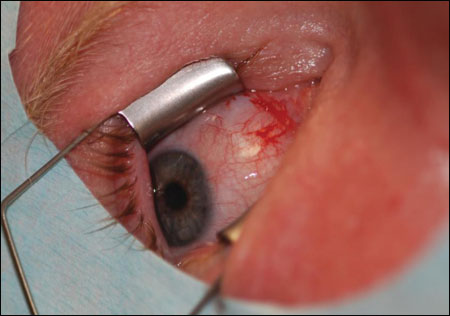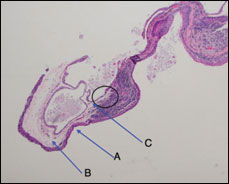Conjunctival lesion occurs in patient with family history of melanoma
A 42-year-old white male was referred to our clinic by his primary care physician for investigation into a lesion on the nasal bulbar conjunctiva of the right eye. The patient reported that a warm piece of drilling slag flew into the same eye a few months earlier. He sought no medical attention at that time. He also said he had a dull ache in that same area of the eye since the incident. His ocular history was otherwise unremarkable.

Raised lesion on the nasal conjunctiva of the patient’s right eye. It appears symmetric, has well demarcated regular borders, shows mild coloration in comparison to the sclera and is elevated.
Images: Genereux L

Immediate post-excision conjunctiva showing complete removal of the lesion with minimal hemorrhage.
The patient’s medical history was positive for achalasia, for which he had been medicated for 4 years with metoclopramide at a dose of 10 mg four times a day. He had also been using a Duoneb (ipratropium bromide 0.5 mg/albuterol sulfate 3 mg, DEY) inhaler four times a day for a year for shortness of breath symptoms. He recently had a cutaneous lesion on his cheek biopsied by his dermatologist and sent for histopathologic analysis, with an eventual diagnosis of a compound nevus. The conjunctival lesion was of concern to the patient because he had a family history of melanoma.
Uncorrected visual acuities were 20/20 in each eye. Pupil testing revealed equally round and reactive pupils with no relative afferent pupillary defect.
Slit lamp examination revealed a raised, 4-mm by 4-mm yellowish-brown lesion on the nasal aspect of the bulbar conjunctiva of the patient’s right eye. The lesion was not painful upon palpation with a cotton-tipped applicator. It was moveable and did not appear to contain an unregulated neovascular supply. It was symmetrical, had regular borders and was faintly pigmented in comparison to the sclera. There was no apparent foreign body present upon slit lamp examination. With the patient’s complaint of irritation and his family history of melanoma, an appointment for excisional biopsy was made.
In the surgical procedure, a subconjunctival injection of lidocaine 2% with 1:100,000 epinephrine was administered to provide both anesthesia and hemostasis. An excisional biopsy was then performed with care to remove all suspect tissue by extending the incision 1 mm beyond the visible borders of the lesion. The specimen was then immersed in 10% neutral buffered formalin solution and sent for histopathological examination.
At this point there were several possible explanations for the patient’s conjunctival lesion. One possibility was that the piece of drilling slag was still in the patient’s conjunctiva and had resulted in a foreign body granuloma. Another possible etiology was that the ocular trauma resulted in formation of a conjunctival cyst or granuloma. With the patient’s recent history of dermatologic biopsy and family history of melanoma, we also needed to investigate the possibility of malignant etiology.
The pathologist diagnosed our patient’s lesion as a simple conjunctival cyst. Histological examination showed an elevated section of conjunctiva filled with cystic fluid and lined with flat squamous epithelium.
Cysts, granulomas, lymphomas
Conjunctival cysts can occur spontaneously or secondary to trauma. As such, we do not know the exact etiology of the lesion in question. However, with the patient’s description of the foreign body injury occurring in the same location as the conjunctival cyst, it is likely that the lesion was a result of the trauma. These cysts present as raised, fluid-filled lesions that may or may not transilluminate depending on their fluid contents. Histological analysis often reveals the presence of goblet cells, which may secrete the luminal fluid.

Lucas Genereux

Leonid Skorin Jr.
Conjunctival granulomas can form as a result of infiltration by foreign bodies of many origins. Inflammatory cells such as neutrophils and multinucleated giant cells aggregate around the foreign body in the body’s attempt to rid itself of the invader. These lesions commonly present as raised, painless, movable lesions that lack neovascularization.
Conjunctival lymphomas classically present as raised, salmon pink lesions of the bulbar conjunctiva. These lesions are often compressible and contain blood vessels that are only slightly dilated. Treatment of conjunctival lymphomas depends on the diagnosis as either benign or malignant, which is achieved through flow cytometry and gene analysis of specimen samples. Benign lesions are either monitored for progression or treated with topical steroids. If a topical steroid regimen does not resolve the lesion or if pathological investigation reveals low-grade neoplasia, low-dose radiation is recommended. Lesions that show a more aggressive neoplasia are given a higher dose of radiation. Conjunctival lymphomas typically respond well to therapy, showing complete regression.
Squamous cell carcinoma

Wide angle histologic image showing the entire conjunctival lesion. Note the consistent organization with surface epithelium (arrow A), stroma (arrow B) and endothelium (arrow C). The circle denotes the location of the next figure.

Magnified view of circled portion from previous figure. The arrows show characteristic goblet cells.
Conjunctival squamous cell carcinomas (SCCs) are the most common type of primary ocular neoplasms in clinical practice. Conjunctival SCCs occur more frequently in older individuals with a history of excessive sun exposure associated with outdoor occupations, cigarette smoking and history of SCC of the skin of the head and neck. They typically present in one of three different ways.
The first is a superficial white keratinized plaque that is known as a leukoplakic lesion. The second is known as a papillomatous lesion, which is a soft tissue mass with increased vasculature. The third presentation is a translucent raised lesion with poorly defined borders known as a gelatinous lesion. Gelatinous lesions tend to be less distinct than the other two varieties.
Risk of malignancy increases when lesions are larger upon presentation, have prominent vasculature, extend onto the cornea or into the sclera, exhibit spontaneous bleeding, are umbilicated and have a strong adhesion to the globe away from the limbus. Treatment of these lesions is variable and can range from excision of suspect tissue to enucleation.
Contrary to popular belief, the fact that this patient’s lesion was not pigmented does not rule out the possibility of it being a conjunctival melanoma. Conjunctival melanomas have a 5-year mortality rate of 23% to 30% and arise as a subtle plaque-like thickening (Peer et al.). This thickening is often in an area of pre-existing pigment otherwise known as primary acquired melanosis.
Discovery of a conjunctival lesion of unknown etiology can be a startling event for the optometrist. With the plethora of lesions that can occupy this area, one can be overwhelmed when making a diagnosis. A basic understanding of the more common types of lesions, as well as the most malicious, will ensure proper diagnosis and management.
When in doubt, lesions should be referred for excisional biopsy. At the very least, removal of the lesion will improve the comfort and cosmesis of the ocular surface and set both the patient’s and clinician’s minds at ease.
Reference:
Augsburger JJ, et al. Yanoff & Duker Ophthalmology, 3rd ed. Maryland Heights: Mosby Elsevier; 2008:240-246.Han SB, et al. Can J Ophthalmol. 2012;47:e6-e8.
Peer J, et al. McKee’s Pathology of the Skin. 4th ed. Philadelphia, PA: Elsevier 2012:1268-1295.
Resnick S, et al. Cornea. 1991:10(1): 59-62.
Schmack I, et al. J Am Assoc Ped Ophthalmol. 2005;9(6):567-571.
For more information:
Lucas Genereux, BS, is a 4th year optometry student attending Pacific University College of Optometry in Forest Grove, Ore. He is serving an externship with Skorin.Leonid Skorin Jr., OD, DO, MS, FAAO, FAOCO, is a Primary Care Optometry News Editorial Board member who practices in Albert Lea, Minn. He can be reached at the Mayo Clinic Health System; (507) 373-8214; skorin.leonid@mayo.edu.
Edited by Leo P. Semes, OD, FAAO, a professor of optometry, University of Alabama at Birmingham and a member of the Primary Care Optometry News Editorial Board. He may be reached at (205) 934-6773; fax: (205) 934-6758; lsemes@uab.edu.
